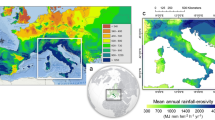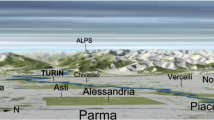Abstract
Rainfall and overland flow are fundamental processes for Earth’s ecosystems but can also be land disturbing forces, particularly when triggered by extreme hydro-meteorological events. Examples of these extremes are rainstorms and related phenomena due to rainfall aggressiveness. They produce high-impact land processes such as soil erosion and nutrient losses. Economic and social consequences of these processes can be quite severe. However, hydrological extremes and their environmental implications are still poorly understood, particularly if analyzed in the context of climate change. Here, we analyze a 300 year long times series of historical rainfall patterns across the Mediterranean in the last three centuries and we investigate changes in the erosive forcing as related to climate changes. Our results show that the erosive forcing increased towards the end of the Little Ice Age (~1850) over western and central Mediterranean and that has been increasing in the recent warming period at low Mediterranean latitudes, due to a higher frequency of intensive storms. Such increased concentrated precipitation may lead to an intensification of land degradation processes triggered by soil erosion and transport across a range of scales from hillslopes to small catchments.




Similar content being viewed by others
References
Baker MB, Peter T (2008) Small-scale cloud processes and climate. Nature 451:299–300
Bender MA et al (2009) Modeled impact of anthropogenic warming on the frequency of intense Atlantic hurricanes. Science 327:454–458
Brown LC, Foster GR (1987) Storm erosivity using idealized intensity distributions. Trans ASABE 30:379–386
Chirico GB, Medina H, Romano N (2010) Functional evaluation of PTF prediction uncertainty: an application at hillslope scale. Geoderma 155:193–202
De Luis M, González-Hidalgo JC, Longares LA (2010) Is rainfall erosivity increasing in the Mediterranean Iberian Peninsula? Land Degrad Dev 21:139–144
Diodato N, Bellocchi G (2010a) MedREM, a rainfall erosivity model for the Mediterranean region. J Hydrol 387:119–127
Diodato N, Bellocchi G (2010b) Storminess and environmental changes in the Mediterranean central area. Earth Interact 14:1–16
Diodato N, Fagnano M, Alberico I (2009) CliFEM—Climate forcing and erosion modelling at long-term Sele river research basin (Southern Italy). Nat Hazards Earth Syst 9:1693–1702
Diodato N, Ceccarelli M (2004) Multivariate indicator kriging approach using a GIS to classify soil degradation for Mediterranean agricultural lands. Ecol Indic 4:177–187
Heuvelink GBM, Burrough PA, Stein A (1989) Propagation of errors is spatial modelling with GIS. Int J Geogr Inform Syst 3:303–322
Hilton RG et al (2008) Tropical-cyclone-driven erosion of the terrestrial biosphere from mountains. Nat Geosci 1:759–762
Lionello P et al (2006) Mediterranean climate variability. Elsevier, Amsterdam, pp 325–372
Matti C, Pauling A, Küttel M, Wanner H (2009) Winter precipitation trends for two selected European regions over the last 500 years and their possible dynamical background. Theor Appl Climatol 95:9–26
Nash JE, Sutcliffe JV (1970) River flow forecasting through conceptual models part I—A discussion of principles. J Hydrol 10:282–290
O’Gorman PA, Schneider T (2009) The physical basis for increases in precipitation extremes in simulations of 21st-century climate change. Proc Natl Acad Sci USA 106:14773–14777
Pauling A, Luterbacher J, Casty C, Wanner H (2006) Five hundred years of gridded high-resolution precipitation reconstructions over Europe and the connection to large-scale circulation. Clim Dynam 26:387–405
Ruin I, Creutin JD, Anquetin S, Lutoff C (2008) Human exposure to flash-floods—Relation between flood parameter and human vulnerability during a storm of September 2002 in Southern France. J Hydrol 361:199–213
Samuels R, Rimmer A, Alpert P (2009) Effect of extreme rainfall events on the water resources of the Jordan River. J Hydrol 375:513–523
Solow AR (1986) Mapping by simple indicator kriging. Math Geol 18:335–352
Touchan R et al (2005) Reconstructions of spring/summer precipitation for the Eastern Mediterranean from tree-ring widths and its connection to large-scale atmospheric circulation. Clim Dyn 25:75–98
Van Oost K et al (2007) The impact of agricultural soil erosion on the global carbon cycle. Science 318:626–629
Wie W, Chen L, Fu B (2009) Effects of rainfall change on water erosion processes in terrestrial ecosystems: a review. Progr Phys Geogr 33:307–318
Acknowledgements
The main idea and most analyses were by N.D., G.B. developed the model and G.B.C. performed the uncertainty analysis and edited the manuscript. We thank Danilo Russo, Lecturer at the School of Biological Sciences, University of Bristol (United Kingdom), for his numerous valuable advices and his careful reading of the manuscript.
Author information
Authors and Affiliations
Corresponding author
Rights and permissions
About this article
Cite this article
Diodato, N., Bellocchi, G., Romano, N. et al. How the aggressiveness of rainfalls in the Mediterranean lands is enhanced by climate change. Climatic Change 108, 591–599 (2011). https://doi.org/10.1007/s10584-011-0216-4
Received:
Accepted:
Published:
Issue Date:
DOI: https://doi.org/10.1007/s10584-011-0216-4




